Bias Correction for Precipitation Simulated by RegCM4 over the Upper Reaches of the Yangtze River Based on the Mixed Distribution Quantile Mapping Method
Abstract
:1. Introduction
2. Materials and Methodology
2.1. Study Area
2.2. Precipitation Data
2.3. Mixed Distribution QM
2.4. Analysis Methods
3. Results
3.1. Correction Performance of Different Distribution Functions
3.2. Correction Performance for Station Precipitation
3.3. Correction Performance for Precipitation Climatology and the Extreme Precipitation Index
4. Discussion and Conclusions
Author Contributions
Funding
Acknowledgments
Conflicts of Interest
References
- Gao, X.-J.; Shi, Y.; Han, Z.-Y.; Wang, M.-L.; Wu, J.; Zhang, D.-F.; Xu, Y.; Giorgi, F. Performance of RegCM4 over Major River Basins in China. Adv. Atmos. Sci. 2017, 4, 441–455. [Google Scholar] [CrossRef]
- Tong, Y.; Gao, X.-J.; Han, Z.-Y.; Xu, Y. Bias Correction of Daffy Precipitation Simulated by RegCM4 Model over China. Chin. J. Atmos. Sci. 2017, 6, 1156–1166. (In Chinese) [Google Scholar]
- Jie, C.; Brissette, F.-P.; Leconte, R. Uncertainty of downscaling method in quantifying the impact of climate change on hydrology. J. Hydrol. 2011, 401, 190–202. [Google Scholar]
- Piani, C.; Weedon, G.-P.; Best, M.; Gomes, S.-M.; Viterbo, P.; Hagemann, S.; Haerter, J.-O. Statistical bias correction of global simulated daily precipitation and temperature for the application of hydrological models. J. Hydrol. 2010, 395, 199–215. [Google Scholar] [CrossRef]
- Haddeland, I.; Heinke, J.; Voß, F.; Eisner, S.; Chen, C.; Hagemann, S.; Ludwig, F. Effects of climate model radiation, humidity and wind estimates on hydrological simulations. Hydrol. Earth Syst. Sci. 2012, 16, 305–318. [Google Scholar] [CrossRef] [Green Version]
- Hagemann, S.; Chen, C.; Haerter, J.-O.; Heinke, J.; Gerten, D.; Piani, C. Impact of a Statistical Bias Correction on the Projected Hydrological Changes Obtained from Three GCMs and Two Hydrology Models. J. Hydrometeorol. 2011, 4, 556–578. [Google Scholar] [CrossRef]
- Piani, C.; Haerter, J.-O.; Coppola, E. Statistical bias correction for daily precipitation in regional climate models over Europe. Theor. Appl. Climatol. 2010, 1, 187–192. [Google Scholar] [CrossRef] [Green Version]
- Navarro-Racines, C.; Tarapues, J.; Thornton, P.; Jarvis, A.; Ramirez-Villegas, J. High-resolution and bias-corrected CMIP5 projections for climate change impact assessments. Sci. Data 2020, 7, 7. [Google Scholar] [CrossRef] [Green Version]
- Ibarra-Berastegi, G.; Saénz, J.; Ezcurra, A.; Elías, A.; Diaz Argandoña, J.; Errasti, I. Downscaling of surface moisture flux and precipitation in the Ebro Valley (Spain) using analogues and analogues followed by random forests and multiple linear regression. Hydrol. Earth Syst. Sci. 2011, 6, 1895–1907. [Google Scholar] [CrossRef]
- Willkofer, F.; Schmid, F.; Komischke, H.; Korck, J.; Braun, M.; Ludwig, R. The impact of bias correcting regional climate model results on hydrological indicators for Bavarian catchments. J. Hydrol. Reg. Stud. 2018, 19, 25–41. [Google Scholar] [CrossRef]
- Gudmundsson, L.; Bremnes, J.-B.; Haugen, J.-E.; Engen-Skaugen, T. Technical Note: Downscaling RCM precipitation to the station scale using statistical transformations—A comparison of methods. Hydrol. Earth Syst. Sci. 2012, 9, 3383–3390. [Google Scholar] [CrossRef] [Green Version]
- Reiter, P.; Gutjahr, O.; Schefczyk, L.; Heinemann, G.; Casper, M. Does applying quantile mapping to subsamples improve the bias correction of daily precipitation? Int. J. Climatol. 2018, 4, 1623–1633. [Google Scholar] [CrossRef]
- Shin, J.; Lee, T.; Park, T.; Kim, S. Bias correction of RCM outputs using mixture distributions under multiple extreme weather influences. Theor. Appl. Climatol. 2019, 137, 201–216. [Google Scholar] [CrossRef]
- Themeßl, M.-J.; Gobiet, A.; Leuprecht, A. Empirical-statistical downscaling and error correction of daily precipitation from regional climate models. Int. J. Climatol. 2011, 10, 1530–1544. [Google Scholar] [CrossRef]
- Teutschbein, C.; Seibert, J. Bias correction of regional climate model simulations for hydrological climate-change impact studies: Review and evaluation of different methods. J. Hydrol. 2012, 456, 12–29. [Google Scholar] [CrossRef]
- Han, Z.-Y.; Tong, Y.; Gao, X.-J.; Xu, Y. Correction based on quantile mapping for temperature simulated by the RegCM4. Adv. Clim. Chang. Res. 2018, 4, 331–340. (In Chinese) [Google Scholar]
- Hempel, S.; Frieler, K.; Warszawski, L.; Schewe, J.; Piontek, F. A trend-preserving bias correction-the ISI-MIP approach. Earth Syst. Dynam. 2013, 2, 219–236. [Google Scholar] [CrossRef] [Green Version]
- Gutjahr, O.; Heinemann, G. Comparing precipitation bias correction methods for high-resolution regional climate simulations using COSMO-CLM. Theor. Appl. Climatol. 2013, 3, 511–529. [Google Scholar] [CrossRef]
- Evin, G.; Merleau, J.; Perreault, L. Two-component mixtures of normal, gamma, and Gumbel distributions for hydrological applications. Water Resour. Res. 2011, 8, W8525. [Google Scholar] [CrossRef]
- Teng, J.; Potter, N.-J.; Chiew, F.; Zhang, L.; Wang, B.; Vaze, J.; Evans, J.-P. How does bias correction of regional climate model precipitation affect modelled runoff? Hydrol. Earth Syst. Sci. 2015, 2, 711–728. [Google Scholar] [CrossRef] [Green Version]
- Strupczewski, W.-G.; Kochanek, K.; Bogdanowicz, E.; Markiewicz, I. On seasonal approach to flood frequency modelling. Part I: Two-component distribution revisited. Hydrol. Process. 2012, 5, 705–716. [Google Scholar] [CrossRef]
- Wuthiwongyothin, S.; Mili, S.; Phadungkarnlert, N. A Study of Correcting Climate Model Daily Rainfall Product Using Quantile Mapping in Upper Ping River Basin, Thailand; Springer: Singapore, 2020. [Google Scholar]
- Li, X.; Lu, R. Extratropical factors affecting the variability in summer precipitation over the Yangtze River basin, China. J. Clim. 2017, 20, 8357–8374. [Google Scholar] [CrossRef]
- Wang, S.; Yuan, X. Extending seasonal predictability of Yangtze River summer floods. Hydrol. Earth Syst. Sci. 2018, 8, 4201–4211. [Google Scholar] [CrossRef] [Green Version]
- Fang, J.; Kong, F.; Fang, J.; Zhao, L. Observed changes in hydrological extremes and flood disaster in Yangtze River Basin: Spatial–temporal variability and climate change impacts. Nat. Hazards 2018, 1, 89–107. [Google Scholar] [CrossRef]
- Huang, Y.; Xiao, W.-H.; Hou, B.-D.; Zhou, Y.-Y.; Hou, G.-B.; Yi, L.; Cui, H. Hydrological projections in the upper reaches of the Yangtze River Basin from 2020 to 2050. Sci. Rep. 2021, 1, 9720. [Google Scholar] [CrossRef] [PubMed]
- Wu, J.; Gao, X.-J. A gridded daily observation dataset over China region and comparison with the other datasets. Chin. J. Geophys. 2013, 4, 1102–1111. (In Chinese) [Google Scholar]
- Li, H.; Sheffield, J.; Wood, E.-F. Bias correction of monthly precipitation and temperature fields from Intergovernmental Panel on Climate Change AR4 models using equidistant quantile matching. J. Geophys. Res. Atmos. 2010, 115, D10101. [Google Scholar] [CrossRef]
- Jung, Y.; Shin, J.; Ahn, H.; Heo, J. The spatial and temporal structure of extreme rainfall trends in South Korea. Water 2017, 10, 809. [Google Scholar] [CrossRef] [Green Version]
- Sunyer, M.-A.; Madsen, H.; Ang, P.-H. A comparison of different regional climate models and statistical downscaling methods for extreme rainfall estimation under climate change. Atmos. Res. 2012, 103, 119–128. [Google Scholar] [CrossRef]
- Wu, J.; Gao, X.-J.; Shi, Y.; Giorgi, F. Climate change over Xinjiang region in the 21st century simulated by a high resolution regional climate model. J. Glaciol. Geocryol. 2011, 3, 479–487. (In Chinese) [Google Scholar]
- Cannon, A.-J.; Sobie, S.-R.; Murdock, T.-Q. Bias Correction of GCM Precipitation by Quantile Mapping: How Well Do Methods Preserve Changes in Quantiles and Extremes? J. Clim. 2015, 17, 6938–6959. [Google Scholar] [CrossRef]
- Kim, K.-B.; Bray, M.; Han, D. An improved bias correction scheme based on comparative precipitation characteristics. Hydrol. Process. 2015, 9, 2258–2266. [Google Scholar] [CrossRef] [Green Version]
- Ji, P.; Yuan, X.; Ma, F.; Pan, M. Accelerated hydrological cycle over the Sanjiangyuan region induces more streamflow extremes at different global warming levels. Hydrol. Earth Syst. Sci. 2020, 11, 5439–5451. [Google Scholar] [CrossRef]
- Todzo, S.; Bichet, A.; Diedhiou, A. Intensification of the hydrological cycle expected in West Africa over the 21st century. Earth Syst. Dynam. 2020, 1, 319–328. [Google Scholar] [CrossRef] [Green Version]
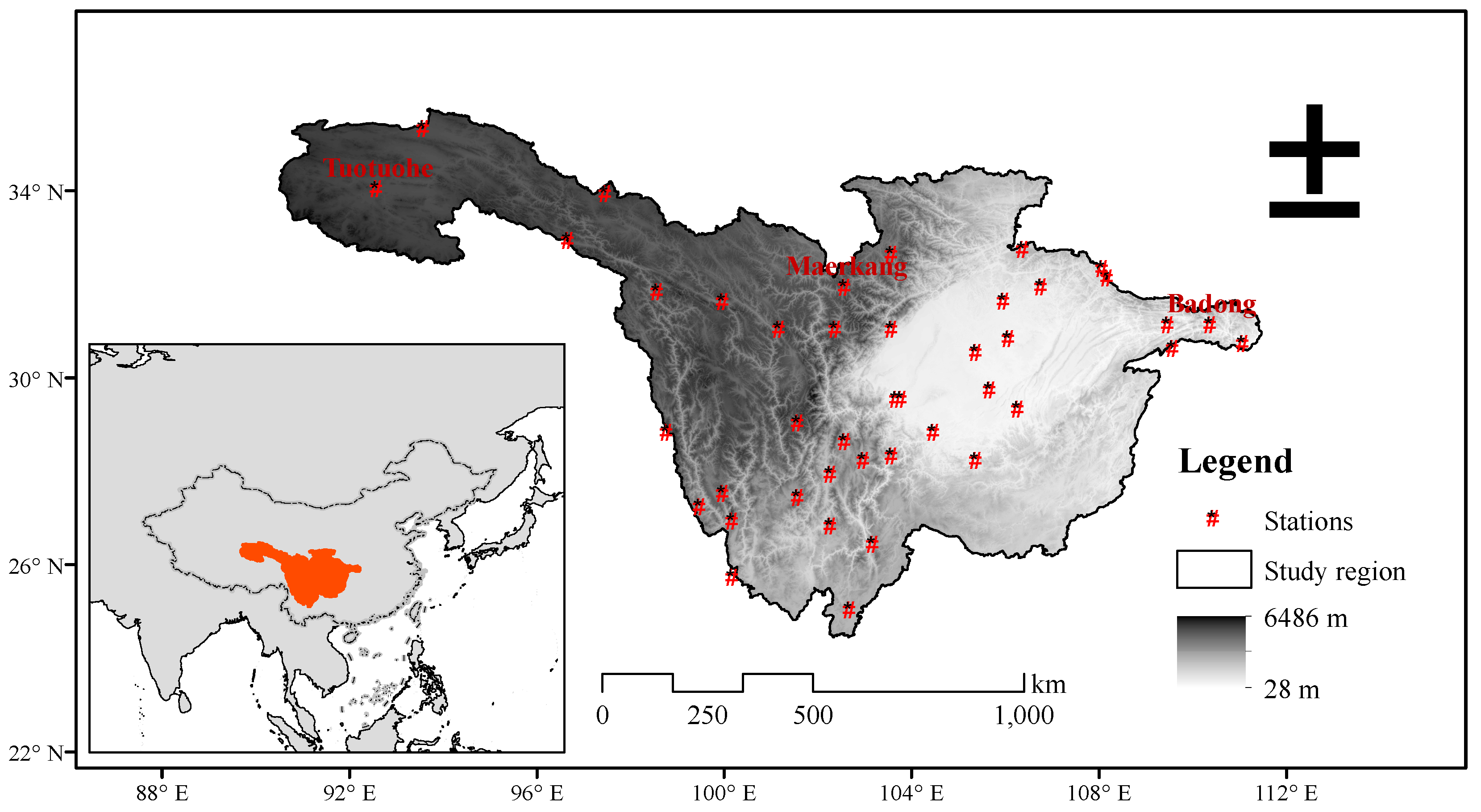

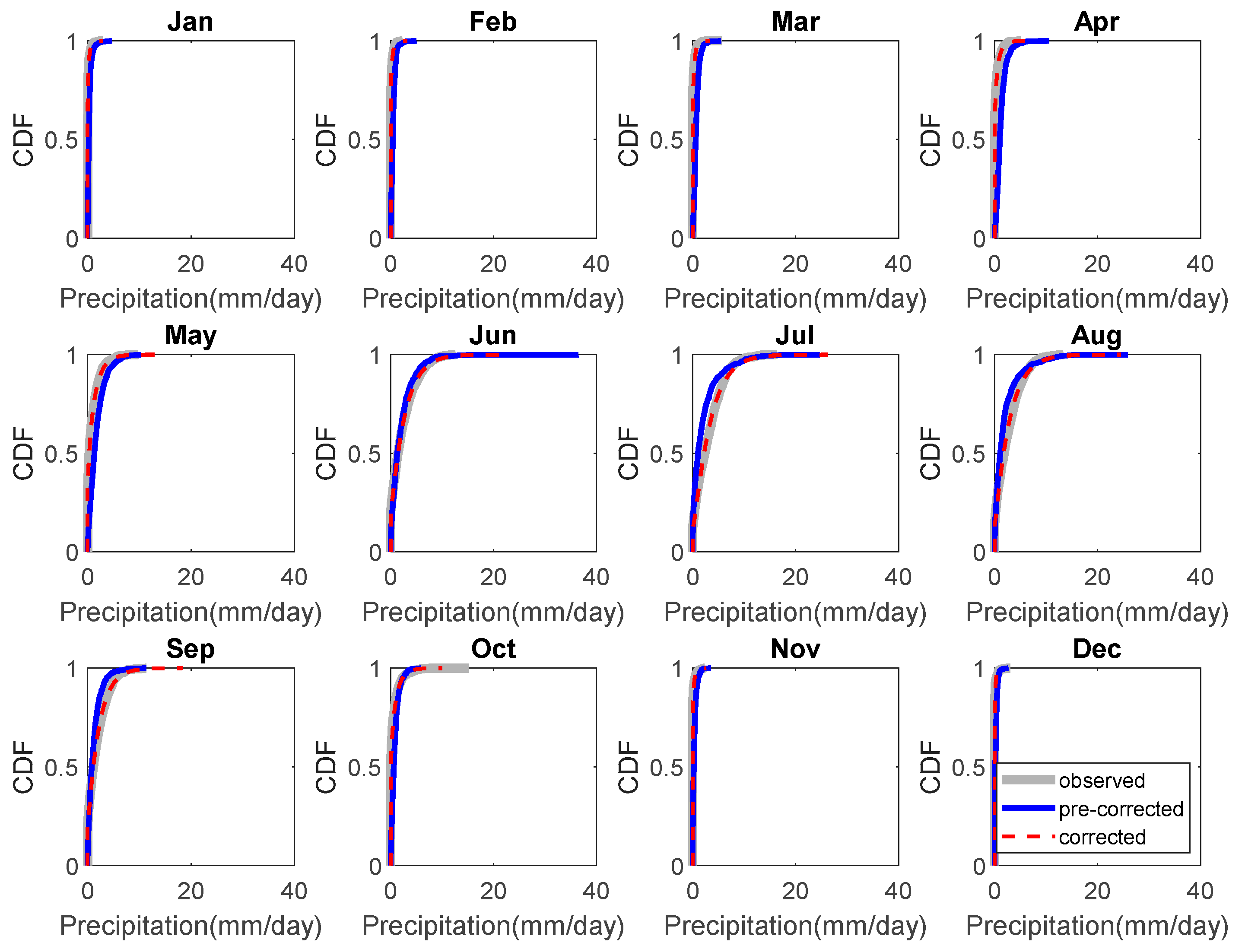
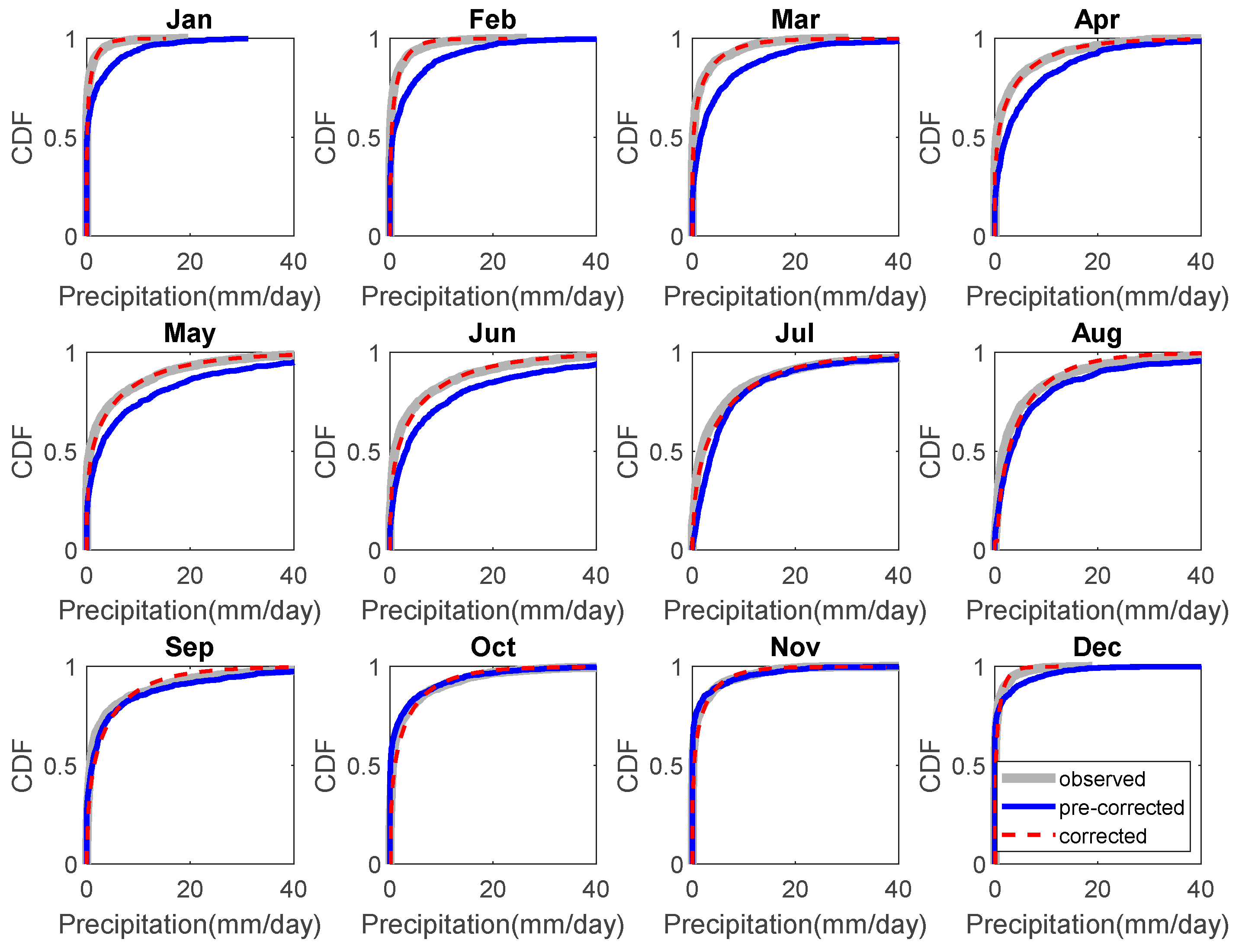
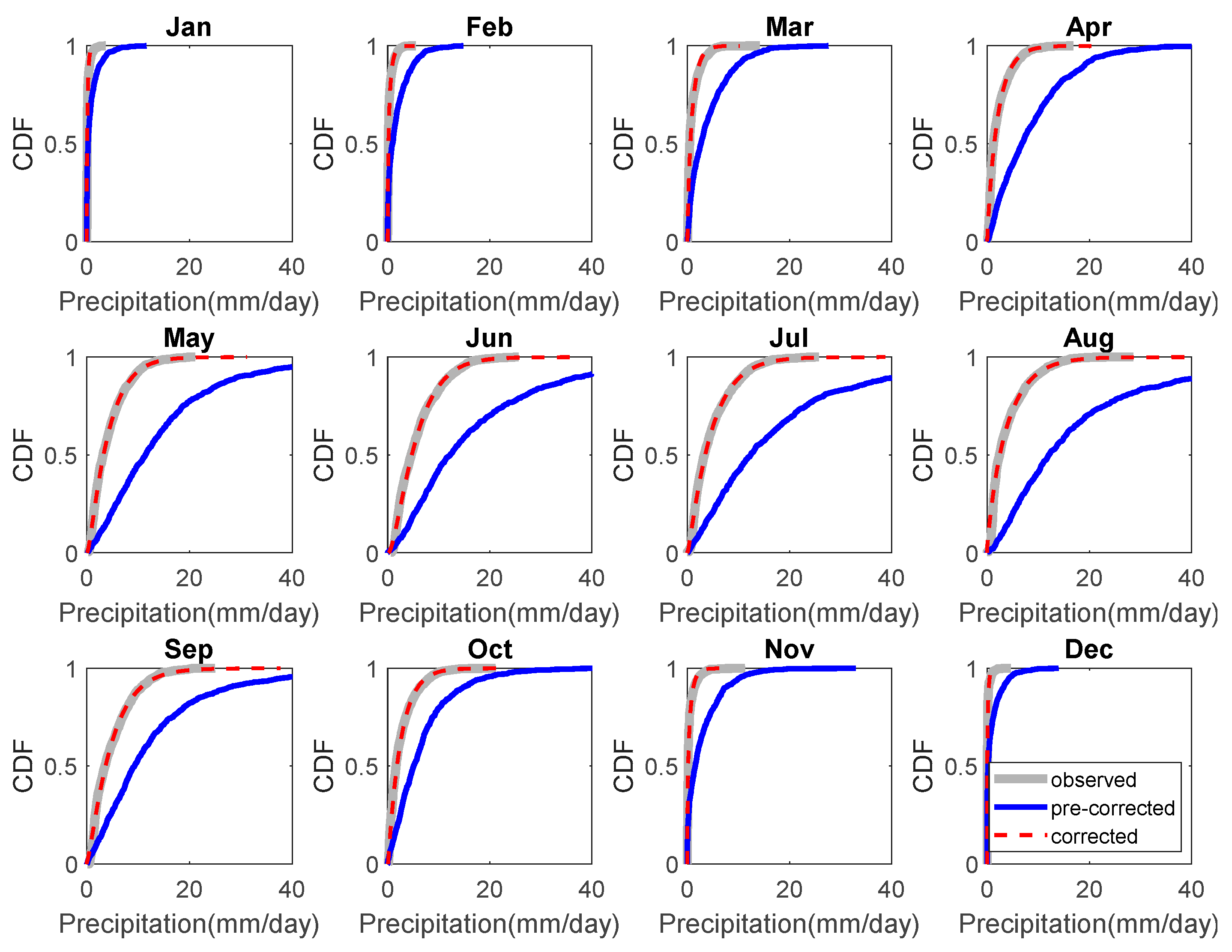

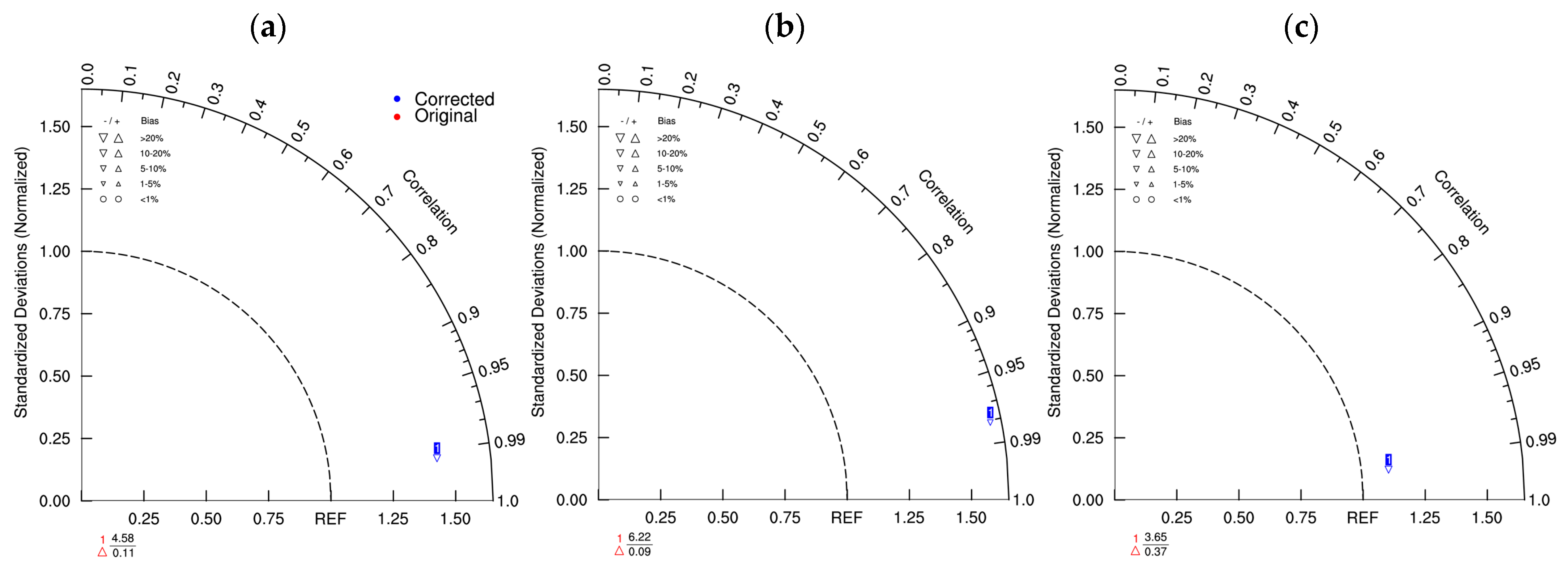
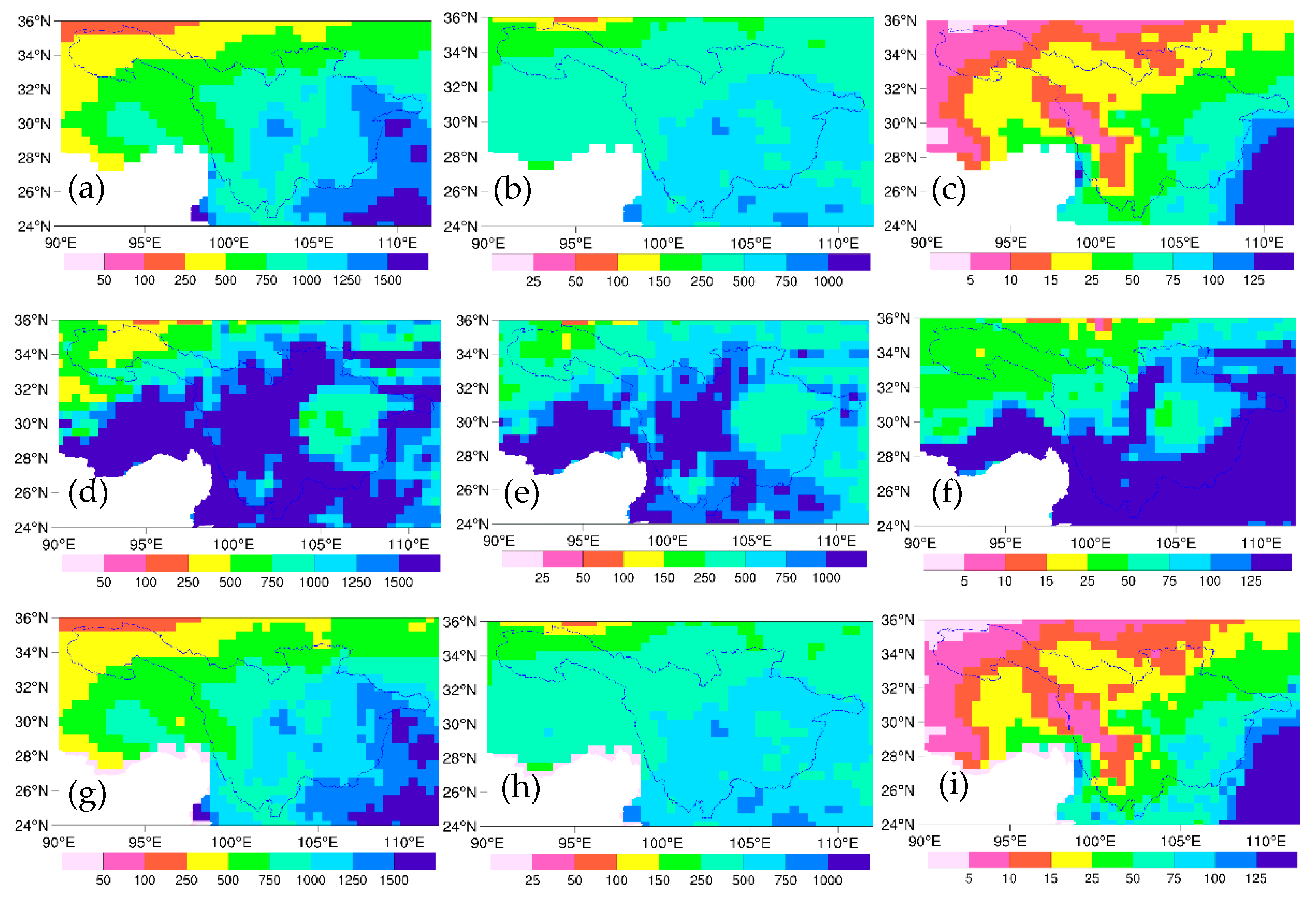
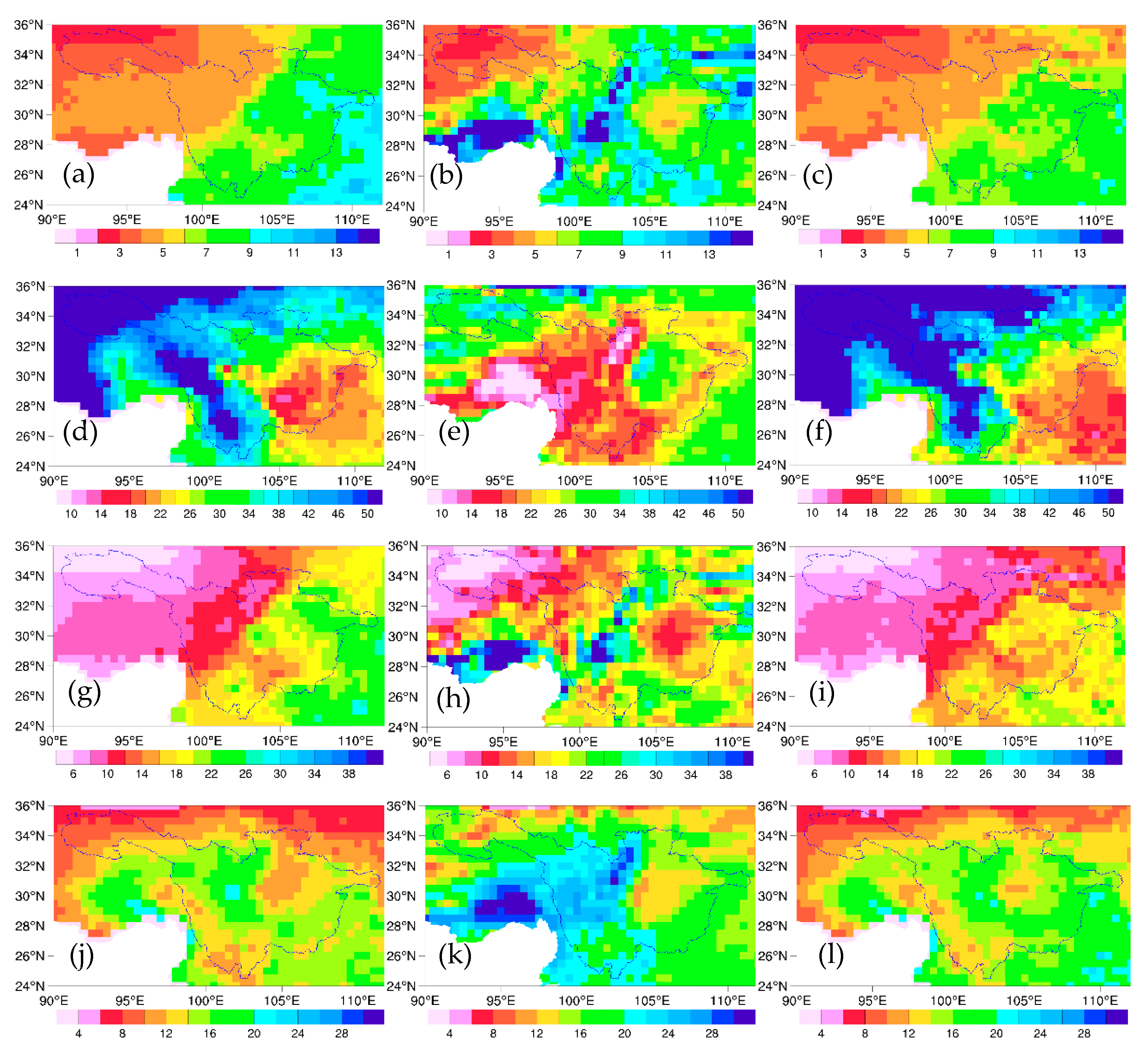
| Contents | Description |
|---|---|
| Domain | 50 km horizontal resolution Central Lat. and Lon.: 35° N, 115° E 200 (Lon) × 130 (Lat) |
| Vertical layers (top) | 18 vertical sigma levels (1 hPa) |
| PBL scheme | Holtslag |
| Cumulus parameterization scheme | Emanuel |
| Land surface model | NCAR CLM3.5 |
| Short-/Longwave radiation scheme | NCAR CCM3 |
| Boundary data | EAR-Interim reanalysis data |
| Simulation period | January 1989–December 2012 |
| ID | Name | Lat (°) | Lon (°) | ID | Name | Lat (°) | Lon (°) |
|---|---|---|---|---|---|---|---|
| 52908 | Wudaoliang | 35.3 | 93.6 | 56565 | Yanyuan | 27.4 | 101.6 |
| 56004 | Tuotuohe | 34 | 92.6 | 56571 | Liangshan | 27.9 | 102.3 |
| 56029 | Yushu | 32.9 | 96.7 | 56651 | Lijiang | 26.9 | 100.2 |
| 56034 | Qingshuihe | 33.9 | 97.5 | 56671 | Huili | 26.8 | 102.3 |
| 56144 | Dege | 31.8 | 98.6 | 56684 | Huize | 26.4 | 103.2 |
| 56146 | Ganzi | 31.6 | 100 | 56751 | Dali | 25.7 | 100.2 |
| 56167 | Daofu | 31 | 101.2 | 56778 | Kunming | 25 | 102.7 |
| 56172 | Maerkang | 31.9 | 102.6 | 57211 | Ningqiang | 32.7 | 106.4 |
| 56178 | Xiaojing | 31 | 102.4 | 57237 | Wanyuan | 32.1 | 108.2 |
| 56182 | Songpan | 32.6 | 103.6 | 57238 | Zhenba | 32.3 | 108.1 |
| 56188 | Dujiangyan | 31 | 103.6 | 57306 | Langzhong | 31.6 | 106 |
| 56385 | Emeishan | 29.5 | 103.7 | 57313 | Bazhong | 31.9 | 106.8 |
| 56386 | Leshan | 29.5 | 103.8 | 57348 | Fengjie | 31.1 | 109.5 |
| 56444 | Deqin | 28.8 | 98.8 | 57355 | Badong | 31.1 | 110.4 |
| 56462 | Jiulong | 29 | 101.6 | 57405 | Suining | 30.5 | 105.4 |
| 56475 | Yuexi | 28.6 | 102.6 | 57411 | Nanchong | 30.8 | 106.1 |
| 56479 | Zhaojue | 28.2 | 103 | 57445 | Jianshi | 30.6 | 109.6 |
| 56485 | Leibo | 28.3 | 103.6 | 57461 | Yichang | 30.7 | 111.1 |
| 56492 | Yibin | 28.8 | 104.5 | 57502 | Dazu | 29.7 | 105.7 |
| 56543 | Diqing | 27.5 | 100 | 57517 | Jiangjin | 29.3 | 106.3 |
| 56548 | Weixi | 27.2 | 99.5 | 57608 | Xuyong | 28.2 | 105.4 |
| Distribution Function | K-S Statistical Parameter | MRE | RMSE | SSE | R | |
|---|---|---|---|---|---|---|
| D | P95 | |||||
| G | 0.32 | 23 | 20.59 | 6.87 | 1.66 | 1.00 |
| E | 0.54 | 8 | 54.90 | 27.08 | 22.74 | 0.98 |
| U | 0.80 | 0 | 164.92 | 43.75 | 63.23 | 0.94 |
| V | 0.38 | 14 | 9.32 | 13.44 | 6.01 | 0.99 |
| G-G | 0.18 | 38 | 1.17 | 1.39 | 0.16 | 1.00 |
| G-E | 0.19 | 40 | −1.26 | 1.35 | 0.18 | 1.00 |
| G-U | 0.37 | 13 | 8.10 | 3.17 | 0.38 | 1.00 |
| G-V | 0.17 | 39 | −1.07 | 1.29 | 0.14 | 1.00 |
Publisher’s Note: MDPI stays neutral with regard to jurisdictional claims in published maps and institutional affiliations. |
© 2021 by the authors. Licensee MDPI, Basel, Switzerland. This article is an open access article distributed under the terms and conditions of the Creative Commons Attribution (CC BY) license (https://creativecommons.org/licenses/by/4.0/).
Share and Cite
Li, B.; Huang, Y.; Du, L.; Wang, D. Bias Correction for Precipitation Simulated by RegCM4 over the Upper Reaches of the Yangtze River Based on the Mixed Distribution Quantile Mapping Method. Atmosphere 2021, 12, 1566. https://doi.org/10.3390/atmos12121566
Li B, Huang Y, Du L, Wang D. Bias Correction for Precipitation Simulated by RegCM4 over the Upper Reaches of the Yangtze River Based on the Mixed Distribution Quantile Mapping Method. Atmosphere. 2021; 12(12):1566. https://doi.org/10.3390/atmos12121566
Chicago/Turabian StyleLi, Bingxue, Ya Huang, Lijuan Du, and Dequan Wang. 2021. "Bias Correction for Precipitation Simulated by RegCM4 over the Upper Reaches of the Yangtze River Based on the Mixed Distribution Quantile Mapping Method" Atmosphere 12, no. 12: 1566. https://doi.org/10.3390/atmos12121566
APA StyleLi, B., Huang, Y., Du, L., & Wang, D. (2021). Bias Correction for Precipitation Simulated by RegCM4 over the Upper Reaches of the Yangtze River Based on the Mixed Distribution Quantile Mapping Method. Atmosphere, 12(12), 1566. https://doi.org/10.3390/atmos12121566







